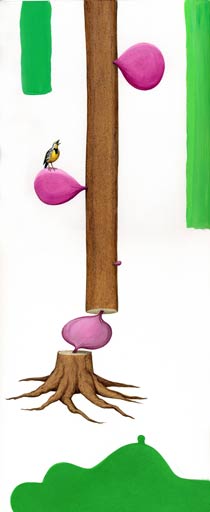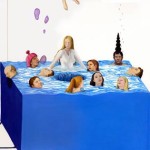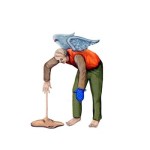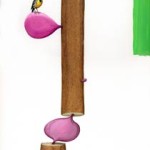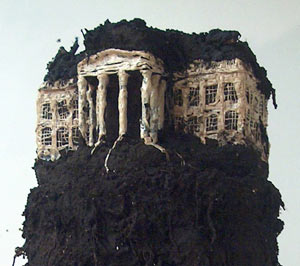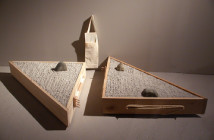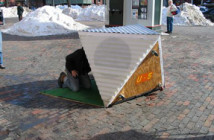Fish begin to rot in the head. On a fresh framed partition sheathed with ash plywood Charles Parker Boggs has laid up caricatures, a psycho-tableau, down the center of the gallery. There are maybe fifty small works - diminutive – mostly acrylic, some gouache and some in sculpted fimo. Like an admonition against perversion (see Brueghel, see Bosch) these depictions delight in portraying the depraved acts of man at his cheery worst. The quote above is a 16th c. Flemish quip after Erasmus the Greek: When the head is sick the whole body suffers.
In Boggs’ portrayal the body is at once sexual and sexless, pious and putrefying. In one of his brightly hued paintings, a winged man is shown leaning forward as if to observe something more closely. That something, to his dismay, turns out to be his own face, which has slipped like syrup from the tip of his finger and is puddled at his feet. Another of the paintings demonstrates a pair of legs, dressed to the nines, whose allure quits just below the delectable demarcation of sex. In Boggs’ portrayal, the omphalos, or the fountain of life, is in retrograde. A blue cube of water bathes many figures, perhaps in baptism. In the tub’s center, the water is spilling through a hole, ready to become a whirlpool. Each image informs those encountered before and vice versa, much like a text.
This show has the decided feel of recto/verso, the two sides of a medieval manuscript page. However, the hybrid inventions of medieval fantasy that were primarily marginal have become thoroughly central to the work. When the marginal becomes central, the viewer’s challenge is to understand his own attraction/repulsion to the subject matter. Unless he has the tools with which to do this, the dredging of psychic muck will be hell for certain.
Charles Parker Boggs is from Harlan, Kentucky and now resides in Hazard. If you know that land, deep Appalachia, then you know its steep folded mountains and secret sleeping hollows. On Halloween they say to stay in. The boys send flaming tires careening down onto narrow forested roads and into the muddy creek bottom. “They burn for a long time,” says Boggs. There are references within this art to a dark heritage; one grown on rolled tobacco and bitumen coal smoldering in the stove. There’s the shotgun still for corn whiskey, not to mention the mountainsides where the kudzu strangles the underbrush, growing a foot a day, and federal land, where wire snares guard illegal cash crop. This is the place where Boggs is from. He’s also from a place where the forest of hickory, and ash, hemlock and white pine has regenerated since the days of massive logging. In one painting bubblegum grows where the chainsaw has split open the old growth. A migratory yellow-bellied sapsucker is shown belting a song despite it all. Boggs too has been migratory. Following his family’s frustration with the involuted spine of the Eastern United States, he has lived and worked in several other places. I would venture to guess however, that the work on display here is born of all that he knows of that home place.
Barring some months spent in Eastern Kentucky, Pieter Brueghel is an alternative entry to understanding Charles Parker Boggs’ work. Brueghel’s nightmarish oddities are proverbs or folk sayings. The tiny man hanging from the tree holds his head in a sack: Er hat den Kopf im Sack. In other words, he doesn’t know which end is up. What is clear about Boggs is that he does know which end is which. This show is either a keen observation of his own psyche or of the psychogeography that generates these strange tales.
- Charles Parker Boggs, In the Pool, acrylic on paper, 2004
- Charles Parker Boggs, Busy Baker, acrylic on paper, 2004
- Charles Parker Boggs, Tree Bird, acrylic on paper, 2004
Links:
Samson Projects
"James Rieck, Charles Parker Boggs, and Brad Hampton: {slice, dice & adhere} is on view until March 26th date at Samson Projects, located at 450 Harrison Ave., Boston.
All images are courtesy of the artist and Samson Projects.

